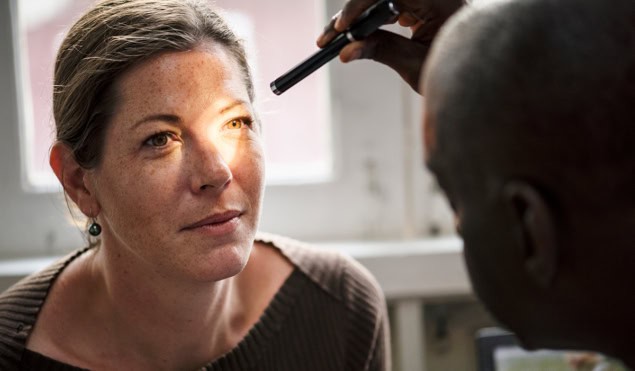
A single dose of radiation can reduce the number of eye injections needed to treat patients with neovascular age-related macular degeneration (AMD). That’s the conclusion of a UK-based clinical trial of more than 400 patients with the debilitating eye disease.
AMD affects 8% of adults globally, and is a leading cause of central blindness in people over 60 in developed nations. Neovascular (or wet) AMD, the most advanced and aggressive form of the disease, causes new blood vessels to grow into the macula, the light-sensing layer of cells inside the back of the eye. Leakage of blood and fluid from these abnormal vessels can lead to a rapid, permanent and severe loss of sight.
The condition is treated with injections of drugs into the eye, with most people requiring an injection every 1–3 months to effectively control the disease. The drugs inhibit vascular endothelial growth factor (VEGF), a key driver of vascular leakage and proliferation. Reporting their findings in The Lancet, the investigators suggest that SRT could eliminate 1.8 million anti-VEGF injections per year globally across all high-income countries.
STAR treatment
The STAR (stereotactic radiotherapy for wet AMD) study, led by Timothy Jackson of King’s College London, is a double-blinded trial that enrolled patients with previously treated chronic active neovascular AMD from 30 hospitals in the UK. All participants received the robotic treatment, with or without delivery of 16 Gy of radiation, at one of three UK treatment centres.
The team used a robotically controlled SRT system that delivers three highly collimated 5.33 Gy radiation beams, targeted to avoid lens irradiation and overlapping at the macula. To stabilize the eye being treated, a suction-coupled contact lens was secured to the cornea and connected to a positioning gimble with infrared reflectors. The SRT device tracked the reflectors, stopping the treatment if the eye moved out of position.
The researchers randomly allocated 274 patients to receive the 16 Gy SRT treatment and 137 to receive identical sham treatment without radiation. Immediately afterwards, all patients received a standard dose of the anti-VEGF drug ranibizumab injected into the eye.
After radiotherapy, participants visited their recruiting hospital for follow-up exams every four weeks up to the 96-week primary endpoint. During these review sessions, patients received an intraocular injection of ranibizumab each time they needed retreatment. The researchers are continuing assessments at three and four years to determine the safety and long-term efficacy of this approach.
The final study analysis included 241 participants in the 16 Gy SRT group and 118 participants in the sham group, with total of 409 patients treated and forming the safety population. The findings are encouraging: patients who received SRT required a mean of 10.7 injections after 96 weeks, compared with 13.3 injections for the conventional drug-only group.
Reducing the burden of anti-VEGF treatment would be highly beneficial for both patients and hospitals. Preliminary analyses suggest that the cost of the SRT treatment may be more than offset by the reduction in injections. The authors plan to prepare a detailed cost evaluation.
Vision outcome for both cohorts was comparable. While the sham group had slightly less worsening of best corrected visual acuity at two years, there was no statistical difference between the two. The systemic safety was also similar in the two groups, with similar rates of adverse events. Evaluation using multimodal imaging determined that 35% of the SRT-treated participants and 12% of the sham group had retinal microvascular abnormalities.
The study outcome supports the findings of a similar phase II clinical trial, INTREPID, whose results were published in 2020. The INTREPID study of 230 randomized patients showed that a single radiation dose of 16 or 24 Gy administered by SRT reduced injections by 29% for the ensuing 12 months, compared with the control group.
Jackson tells Physics World that the researchers are currently analysing data from patients reporting for their three- and four-year anniversary examinations. The data suggest increasing benefit with respect to injection frequency over time. The investigators also note that the benefits of SRT may be eroded by the introduction of newer intravitreal drugs such as faricimab, or higher doses of existing anti-VEGF drugs, which have longer dosing intervals than ranibizumab.

Adaptive optics pioneers win Rank Prize for retinal imaging breakthroughs
Writing in an accompany commentary in The Lancet, Gui-shuang Ying and Brian VanderBeek of the University of Pennsylvania Perelman School of Medicine state: “The STAR study has indicated a potential alternative treatment paradigm that appears to significantly reduce treatment burden without impacting visual acuity outcomes over two years, but additional gaps in knowledge need to be addressed before the widespread adoption of this therapy.”
They add: “If the reduction in anti-VEGF injection rate, non-inferior visual acuity results and acceptable safe profile of SRT remain through future studies, the STAR study will be a foundational piece in advancing a promising adjunctive therapy forward. Patients eagerly await the day when the injection burden is reduced, and SRT might well be a path to getting there.”



